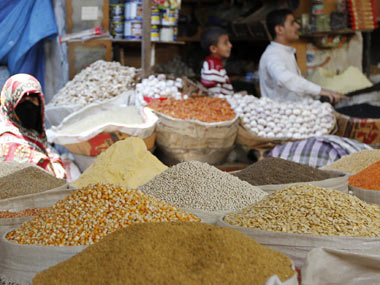The cabinet on Wednesday issued an executive order to start a Rs 1.3 lakh crore ($22 billion) welfare programme that would bring cheap food to hundreds of millions of poor people throughout the country.Despite the order however, both houses of parliament must vote on the programme when they meet for the Monsoon session later this month.
The programme, which will provide highly subsidized food to about two-thirds of India’s population, is seen by many as a key initiative of the ruling Congress party, and one that could potentially help them win votes in the 2014 general elections.Despite being one of the biggest producers of food supplies, India is home to 25 percent of the world’s hungry poor, according to a UN agency.
The controversial Food Security Bill is also expected to increase the government’s fiscal burden. The bill, which provides two-thirds of the population the right to 5 kgs of foodgrain every month at highly subsidised rates of Rs 1-3 per kg will cost the government around Rs 1.25 lakh crore for FY14.
[caption id=“attachment_927901” align=“alignleft” width=“380”] Reuters[/caption]
Reuters[/caption]
Here are the highlights of the bill:
•The programme aims to provide subsidized wheat and rice to 70 percent of India’s population. When implemented, the scheme will massively broaden an existing programme of providing cheap food to 218 million people.Overall, it will entitle around 80 million of India’s 1.2 billion population to subsidised foodgrain under the Targeted Public Distribution System.
•States are given the responsibility to decide on eligibility criteria based on socio-economic and caste census (SECC) data. However the SECC survey is likely to take six more months.
•Up to three-quarters of people in the rural areas and up to half of the urban population would get five kilograms of grains per month at subsidized prices (3 rupees per kilo for rice, 2 rupees per kilo for wheat and 1 rupee per kilo for coarse grains).
•The poorest households would continue to receive 35 kilograms of grains per month under the “Antyodaya Anna Yojana” at subsidized prices.
•Pregnant women and lactating mothers would receive a maternity benefit of at least Rs 6,000 .
•Children aged six months to 14 years will get take-home rations or hot cooked food.
•The central government will also provide money to states and union territories if it runs low on grain as well as providing them with"assistance" towards the cost of intra-state transportation and handling of grains.
•In a bid to give women more authority in running their households, the oldest adult woman in each house would be considered the head of that household for the issuing of ration cards.
• At the coverage and entitlement now proposed, the total estimated annual foodgrains requirement is 612.3 lakh tons and the corresponding estimated food subsidy for implementation of NFSB, at 2013-14 costs, is about Rs. 1,24747 crore.
• There will be state and district level redressal mechanism with designated nodal officers. Redressal mechanism may also include call centers, helpline etc.
• The Bill provides for penalty to be imposed on public servants or authority, if found guilty of failing to comply with the relief recommended by the District Grievance Redressal Officer
What are the concerns with the bill?
•Critics say beneficiaries do not stand to gain as about 40 percent of rice and wheat earmarked for the poor gets siphoned off due to corruption. An inefficient distribution channel also leads to waste.
•Implementing the bill in a fair, equitable and transparent manner is going to be a big challenge for the government.
•Many agriculture experts believe that Food Bill which proposes to provide grains to people at very cheap rates may discourage the agriculture production in the country. Hence it must make sure thatfarmers should not be burdened with the cost of subsidising the supply
•The rollout of the food security programme will also mean that the government’s food subsidy bill will rise to Rs 1,24,724 crore in a year (at 2013-14 cost basis). Budget 2013-14 had pegged the subsidy at Rs 90,000 crore.The bill comes as government is struggling to prune its high fiscal deficit by trimming its extensive spending, and the currency, the rupee, is at an all-time low.
• When compared to the estimated food subsidy requirement under existing TDPS and Other Welfare Schemes, the additional food subsidy implication is about Rs.23,800 crore per annum.
•This new spending will increase India’s fiscal deficit and could well lead to a downgrade of the country’s sovereign rating to junk status.
•Experts believe the rush to pass the bill implies the intent is nakedly political
•Economists of the Government’s Commission for Agricultural Costs and Prices (CACP), who define the roadmap of agricultural policies, have calculated “additional” subsidy burden of Rs 1.20 lakh crore per annum from the existing Rs 90,000 crore
•Centre intends to delegate the task of construction of additional storages to the States, which may not be practically feasible under strained Centre-States relations amongst diverse political parties.
• Government does not even have enough storage capacity to store the amount of grain that it currently procures and will have to procure from the farmers in the years to come.So more grains could be dumped in the open and will rot as a result
)